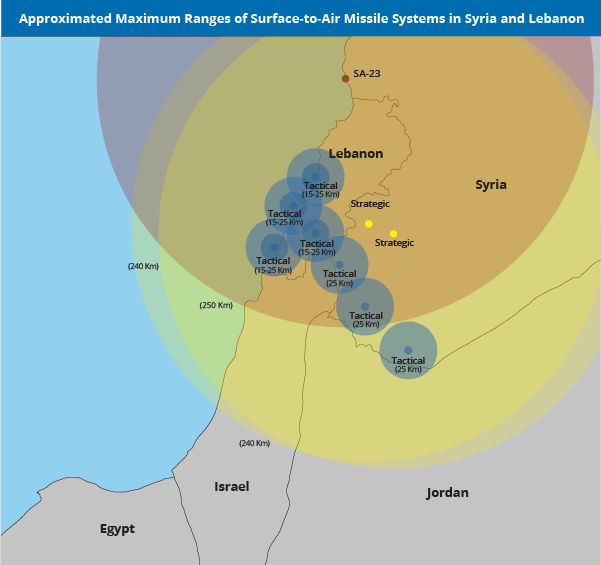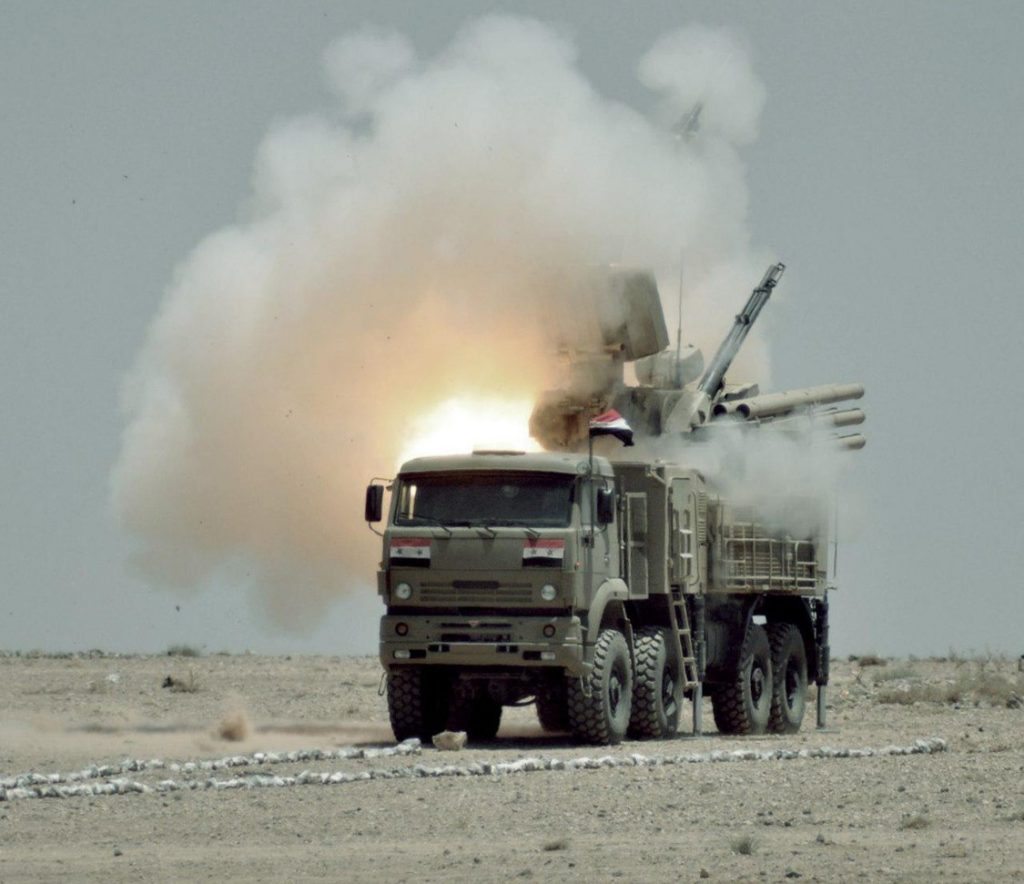Executive Summary
- Recent engaging of Israeli Air Force (IAF) aircraft by surface-to-air missile launched from Syria is indicative of the remaining, albeit limited capabilities of the Syrian Air Defense Forces (SyADF).
- Moreover, it likely points to a shift in the Syrian government’s approach to perceived violations of its sovereignty by Israel, taking a more proactive and aggressive military stance, likely due to recent successes and strong backing from Russia.
- As the IAF’s volume of operations is unlikely to be hindered by this reemerging threat, similar incidents are liable to occur in the coming months. While not posing a direct threat, these still pose a very limited indirect threat to civil aviation, particularly in Israel’s northern areas.
Background: Syria
Prior to 2011, Syria maintained a strong air defense force – the Syrian Air Defense Forces (SyADF). Its reference threats were primarily from Israel and to a lesser degree from Turkey, featuring a possible conflict with a superior air force, and lending to an investment in assets that would offset their enemies’ advantages, namely surface-to-air missiles. This was set up as a layered defense, with a variety of stationary, mobile, and man-portable systems allowing to cover the greatest possible ranges while offering redundancy and survivability of assets in case these systems would be targeted.
Following the commencement of the Syrian civil war, the Syrian government’s reference threat changed from that posed by a neighboring conventional military to that posed by domestic paramilitary forces that strictly rely on land warfare in regular and irregular fighting scenarios, namely rebels and militants. This induced a change in the Syrian Armed Forces’ force structure and resource allocations, which placed the SyADF at a lower priority compared to other forces deemed more valuable to the new type of conflict. Additionally, large numbers of the SyADF platforms were captured or destroyed by rival forces throughout the conflict, significantly damaging its capabilities. That being said, the SyADF was not disbanded and was still maintained as a fighting force, however not to a comparable level to that of the pre-war era.
Relevant systems:
Stationary: SA-2, SA-5 – maximum range 240 km.
Semi-mobile: SA-3 – maximum range 35 km.
Semi-mobile: Russian operated in Syrian territory: SA-23 – maximum range 250 km.
Mobile: SA-6, SA-8, SA-9, SA-11, SA-13, SA-17, SA-19, SA-22 – maximum range 35 km.
Man-portable air-defense systems (MANPADS): SA-7, SA-14, SA-16, SA-18, SA-24- maximum range 5 km.
Background: Hezbollah
Historically, Hezbollah, due to its status as an organization committed to guerilla warfare in the military sphere and the difficulties associated with operating high-profile weapons system resulting from Israel’s longstanding aerial superiority over Lebanon, was not able to acquire surface-to-air platforms. Instead, the organization made efforts to acquire man-portable air-defense systems (MANPADS), which are of lower profile however also have significantly limited capabilities.
That said, due to Hezbollah’s large-scale intervention in the Syrian conflict in support of the government, the organization increasingly adopted conventional tactics and weapons systems, including being trained and gaining experience in the operation of surface-to-air missile systems. Additionally, operating in Syria made it more difficult for Israel to acquire the same level of intelligence and take comparable measures against Hezbollah as it does in Lebanon. As a result, Hezbollah constantly makes significant efforts to acquire mobile surface-to-air systems in order to offset Israel’s relative advantages against the group, in preparation for a future possible broad conflict between the sides. Such mobile systems have reduced ranges compared to the stationary ones, but also require less infrastructure and support to operate, and have a lower profile increasing the survivability rate.
In this context, there are unconfirmed reports that the group was able to acquire an SA-8 and according to reports, the IAF foiled several Hezbollah attempts to acquire SA-17s, however it cannot be ruled out that such an attempt was successful at some point in time. Additionally, even if acquired by Hezbollah, it remains possible that such systems are still in Syria, and were not yet deployed to Lebanon. Lastly, there are unconfirmed reports that Iran had exported Shahab Thaqeb platforms, a copy of the chinese HQ-7, to Hezbollah.
Relevant systems:
Mobile: SA-8, SA-17, Shahab Thaqeb- maximum range 8/25 km.
MANPADS: SA-7, SA-14, SA-16, SA-18, QW-1, Misagh-1, Misagh-2 maximum range 5.2 km.
Assessments & Forecast
The remaining capabilities of the SyADF, limited as they currently are, were portrayed in the recent firing of an SA-5 against an Israeli Air Force (IAF) aircraft on March 17. This retaliatory action is notable as the overwhelming majority of previous airstrikes against pro-Syrian government targets that were attributed to the IAF, as recent as November 30 2016, did not encounter any direct countermeasures by the SyADF.
Furthermore, the incident comes amidst ongoing general positive momentum for the Syrian government and its allies (including Hezbollah) in the ongoing Syrian conflict, which yielded several strategic successes. This likely contributed to a shift in the Syrian government’s position regarding what it perceives as a violation of its sovereignty by Israel, placing it as a “red line” which warrants immediate countermeasures, possibly followed by a more calculated retaliation, which Israel likely preempted in a subsequent airstrike on March 19. The calculated nature of events are further evident in the immediate summoning of the Israeli ambassador by Russia, which backs the Syrian government, as well as the seeming coordination with the Syrian Foreign Minister, who sent letters to the UN’s Secretary General and President of the Security Council accusing Israel of violating Syrian sovereignty and UN resolutions. Moreover, this serves as indication of the strong support lent to the Syrian government by Russia, which is a major factor contributing to the aforementioned shift in strategy.
With this in mind, further similar incidents in which IAF aircraft are engaged by the SyADF following airstrikes against targets in Syria are likely to occur in the coming weeks and months, following the aforementioned shift in the Syrian government’s strategy. This is particularly likely since the IAF is liable to maintain its current strategy of limited scale and scope operations in Syria in order to prevent Hezbollah from acquiring what Israel perceives as “game changing” weapons systems, or to eliminate fighters perceived as planning direct military action against Israel, both of which designated as “red lines” by Israel. To a lesser extent such a response may be conducted by Hezbollah should they be able to acquire relevant weapons systems, given the strong cooperation between the Syrian government and Hezbollah, as well as due to the IAF’s use of Lebanese airspace to conduct at least some of its airstrikes in Syrian territory. However, Hezbollah is more likely to retain such valuable assets for use as a strategic surprise in a possible future round of hostilities with Israel and not to expose them and thus risk losing them in what Hezbollah perceives as a less important scenario.
However, the new situation may entail further complication between Russia and Israel, given the former’s staunch support for the Syrian government, in which Russian forces currently in theater will confront IAF aircraft should the letter be perceived as posing a strategic threat to the Syrian government and Russian regional interests. Such a scenario would not be unprecedented, as Russian aircraft reportedly scrambled in the past to confront IAF aircraft in or near Syrian airspace, most recently as April 2016. While so far such incidents did not result in hostilities between Russian and Israeli forces, a recurrence of IAF airstrikes in Syria facing ground fire, as is currently expected, contributes to growing tensions between Israel and Russia, and through that the possibility, albeit a low-likelihood one, of direct hostilities between the sides, most likely as result of a spiral of mistakes and/or miscommunication.
Taken as a whole, at this time any possible firing of a surface-to-air missile from Syrian territory in response to an IAF airstrike is liable to target IAF military aircraft. However, while not posing a direct threat, such events will pose an indirect threat to civil aviation in the region to a limited degree. This is due to the fact that in case a missile misses its designated target due to maneuvering or countermeasures, and is not intercepted as was the case in the latest incident, the missile may automatically lock on and engage the nearest available target, regardless of if it is military or civilian. At the current state of affairs the Syrian government is uninterested in an escalation with Israel and thus the SyADF is unlikely to engage aircraft over central Israel, despite potentially having the capabilities to do so, as this too will be considered a “red line” by Israel, and therefore such a risk is limited to the northern areas of the country.
Interested in signing up to receive more special reports such as this? Sign up here for a free trial.
This report was written by:
Tzahi Shraga – MAX Security’s Chief Intelligence Officer, ret. LTC from the Israeli intelligence community
Oded Berkowitz – MAX Security’s Associate Director of Intelligence, Middle East & North Africa

